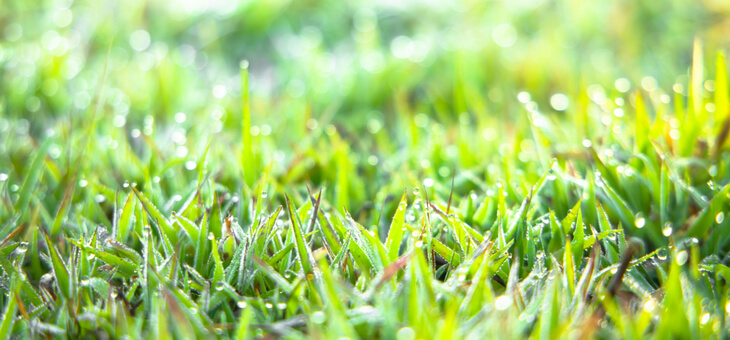Lawns have been a prized fixture in Australian gardens since European settlement. Many people take huge pride in the sight of their perfectly manicured lawn, but they have come under fire recently for their impact on the environment.
A 2018 study conducted by the University of Western Australia and the Swedish University of Agricultural Sciences looked at research from across the world on the impact of maintaining lawns.
Read: Convert your manicured lawn into a wildlife retreat
Researchers found that the things needed to keep a lawn maintained such as high water consumption, the use of pesticides, and the gas emitted from mowing, were all factors that had a significant impact on the environment.
But there are ways to keep our precious lawns and decrease the environmental impact.
Smaller and smarter
“Most of the time it’s about making a lawn area smaller and smarter,” says urban landscape designer Darin Bradbury, director of Mint Design. While people are trending more towards fruit trees and edible plants, he says we still value having open space somewhere in our gardens, especially people with young children or pets.
Mr Bradbury advises “greening out the boundary areas and screening out neighbours, and bringing the lawn in a bit so it’s only as big as it needs to be”. For high-traffic areas, he says, there really is no substitute for lawn. A healthy, green, living, breathing lawn can cool your house, provide a foraging habitat for insects and birds and even improve your mood.
Think about rewilding
That doesn’t necessarily mean allowing your entire outdoor space to revert to its natural state, but instead to leave some parts of it undisturbed and to manage the rest in a wildlife-friendly way.
A wilder lawn lets other species – even weeds – grow and flower to provide habitat and food for insects and birds.
“There is definitely a move towards less-manicured, less-uptight lawns,” says Tim Sansom from the Diggers Foundation. “They are mostly now seen as part of the landscape and they’re allowed to be a bit more natural.”
Read: How rewilding can boost your garden – and your life
It’s all in the soil
In addition to shrinking your lawn, and letting it grow wilder, soil preparation is also vital. As well as using compost, clay should be added to sandy soil and, conversely, dense soil should be helped to drain freely.
Jack Tickenoff, who has worked with plants for more than 20 years and runs a nursery in Western Australia, agrees lawns are a beautiful thing but difficult to maintain in Australia.
“A lot of us are built up against the coast [in WA], which is pretty much a sand dune. So, when we try to water anything on sand, the water just goes straight through.”
However, by preparing the soil correctly, using alternative watering methods, and reusing water, Mr Tickenoff says lawns can be more sustainable.
“We like to add clay and it just sort of fills up the porosity of the sand so it’s not going to leak all the water,” says Mr Tickenoff.
“We can use water that’s already been used – for instance, grey water out of your house, washing machine water, that sort of thing.”
Choose the right groundcover
“If you choose the right lawn for your climate and soil type, you will not need herbicides and very little fertiliser,” says Deryn Thorpe from gardening podcast All The Dirt.
“If you cut your lawn and let the leaf bales fall back on to it, this acts as a natural fertiliser. I also tend to fertilise with compost, worked down between the blades of the grass, rather than using inorganic fertilisers.”
If you’re absolutely set on having grass in your yard, there are lower maintenance varieties available. But they can be pricey.
For example, a premium Zoysia variety, originally developed for golf courses is three times more expensive than typical lawn grass. But it’s a delicious dark green by nature, can handle shade and sun and is drought tolerant.
While a typical lawn requires mowing every two to three weeks, Zoysia means you’ll only have to get out the mower a few times each year.
Buffalo grass is a cheaper alternative that is durable and needs less maintenance and less mowing.
Avoid artificial lawn
There’s no one-size-fits-all solution – although what not to do is resoundingly clear.
“If you don’t want to mow a lawn, make sure the alternative is also permeable, such as mulch, gravel, decking or garden,” says Millie Ross, senior researcher and presenter with Gardening Australia. “But promise me, lay off the plastic lawn. It’s hot, weeds germinate easily in it and in just a few years it will break down – don’t do it!”
Read: Pros and cons of artificial lawn
Generally, experts believe that a mixture of lawn and plants is ideal but there are no fixed rules.
“Look at what you want from your garden and what time you have to give it. An organic lawn can be just as useful as any other well-tended patch. So mix it up or mow it down. Just make sure you grow something,” says Ms Ross.
Do you have a lawn? Do you find the upkeep hard work, or do you enjoy tending to it? Why not share your thoughts in the comments section below?
If you enjoy our content, don’t keep it to yourself. Share our free eNews with your friends and encourage them to sign up.

